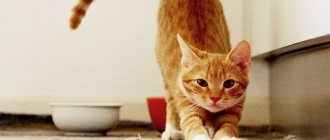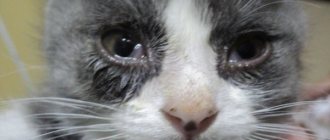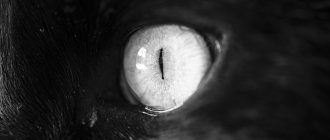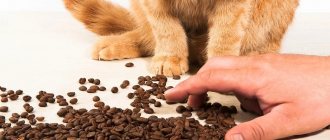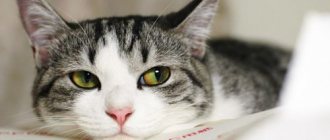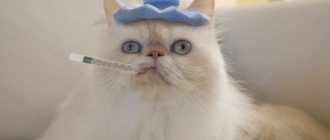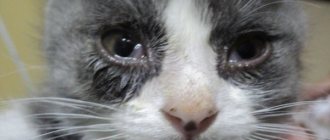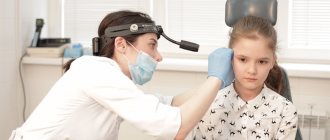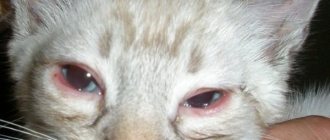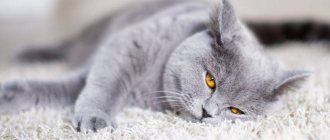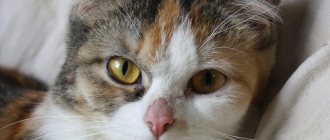For every cat owner, a source of pride is its shiny and beautiful coat. As soon as the cat begins to actively lose its fur, spreading its fur throughout the apartment, especially when the cat's shedding is prolonged, the owners begin to worry. And the cause of concern is not only frequent wet cleaning in the apartment due to the large amount of cat hair, but also whether your pet is sick.
Is shedding normal in a cat or is it one of the symptoms of some disease?
Seasonal shedding. Molting is inherent in all living beings. A cat living in a city apartment is no exception. In the spring, cats change their “coat” in accordance with the growing warmth in nature, and in the fall, with the approach of cold weather, that is, the cat’s owners observe the process of losing and growing new hair. During shedding, the cat behaves as usual, its appetite is preserved, and it does not outwardly look sick. When a cat sheds, it leaves behind a large amount of fur. To keep your pet's coat smooth and fluffy during shedding, try to choose the highest quality premium food. Brush your cat regularly using special brushes and combs. In cats living in city apartments, shedding can last from 2 to 3 months.
Apartment molt . Cats living in an apartment shed all year round, despite good nutrition, absolute health and quality care. Such cats practically do not feel the change of seasons: the molting period in indoor cats stretches for several months, or even the whole year. Indoor shedding intensifies in winter, when the heating starts working in the house or apartment, and the drier the air in the room, the stronger the cat’s shedding. Air conditioners, air humidifiers, and even simple aquariums can partially help owners cope with indoor shedding. For such a cat, owners need to choose suitable food and professional hygiene products (shampoo, conditioner, nourishing masks). Anti-shedding vitamins for cats are effective, but they should not be abused - a maximum of two monthly courses per year.
Baby shedding is the process of changing a kitten's fur to adult fur. Kittens begin to shed at 6 months of age. Molting in kittens continues for 1-2 months. Coarser adult hair grows back, which is thicker and heavier than baby fur. At the same time, the patterned kittens become brighter - the ghostly haze disappears, and the slight fading of the fur, necessary for camouflaging the young, disappears. The dark areas of the skin of Siamese and Burmese become brighter and richer. During a child's coat change, no remedy for shedding cats will help; the owner can only comb the coat daily and make sure that the baby is fed well. The better the living conditions, the faster the coat will change and the more beautiful the adult coat will be.
Pregnancy and feeding kittens . Loss of a significant amount of hair, up to partial baldness, can also be noted in pregnant cats because... During pregnancy, a profound restructuring of metabolism occurs in a cat’s body, and the cat primarily spends the nutrients supplied with food on building the body of the kittens and on their subsequent feeding. After a cat stops feeding her offspring, her coat returns to normal and looks like before pregnancy.
Old age of the cat. Owners often notice thinning fur in older cats around the ears and face. This hair loss does not require special drug treatment; you will need to consult a specialist about feeding an aging cat.
Stressful situations - all animals, including cats, can worry and experience severe nervous overexcitation, which ultimately negatively affects their health, as well as the quality of their coat. A trip to the country, a change of place of residence, the arrival of a new tenant, a fight with its relatives during a walk, meeting a dog, quarrels between family members can become reasons for a cat’s distress. If your pet sheds because of this, then it is important to create a calm atmosphere, surround it with attention and care, and provide sedatives.
Improper grooming is often the reason why a cat sheds all year round. In the case when the cat is clinically healthy, and the change in coat is not pronounced - it sheds little by little and all year round, it is necessary to pay attention to the composition of shampoos, the quality of brushes and other grooming tools. Owners should brush their cat at least once a week: gentle movements with the brush stimulate blood circulation, improving nutrition of the hair follicles and reducing shedding. Shampoos and conditioners must be chosen specifically for cats, and do not forget to dilute them as written on the packaging.
Seasonal molting and its timing
Seasonal molting occurs twice a year: from February to March, the cat gradually prepares for summer, getting rid of winter fur, and from September to October, on the contrary, it strives to make room for a warm winter coat. The timing of shedding may vary depending on the breed of the cat, its climate zone, and the pet’s living conditions, but on average it lasts 2–3 weeks.
During shedding, a cat's behavior may change somewhat: it becomes less active, licks itself frequently, and some pets become irritable. But the general condition should not suffer: the nose should be cold, the eyes should be clean, the food should be eaten, and the tray should be visited as scheduled.
During normal shedding, the amount of fur a cat sheds increases, but does not become excessive . The replacement occurs evenly, without the formation of areas of focal alopecia (baldness).
During shedding, the cat often licks itself to remove dead hairs.
Actions in case of pathological condition
First of all, pay attention to the well-being of the pet. If the cat feels normal, it is necessary to switch to super-premium hypoallergenic food.
The use of vitamin supplements along with natural food or economy-class food is dangerous.
An overdose will only increase shedding. If the cat feels unwell or changing food does not help, seek qualified help.
Be sure to read:
A cat's hair is falling out: reasons, what to do during shedding, treatment of baldness, approved medications
Features of shedding of some breeds
How a cat sheds is largely determined by its breed. The amount of hair left behind by a shedding cat is affected not only by the length of its coat (guard hair), but also by the density and length of the undercoat.
If we consider cat breeds according to the intensity of shedding, they can be divided into:
- highly shedding cats with a lot of undercoat: Persian and Himalayan cats;
- Maine Coon;
- British cat;
- Angora cat;
- Siamese cat;
- sphinxes - depending on the variety, hair may be completely absent or its length may be no more than 2 mm;
Shedding in sphinxes is minimal due to the almost complete absence of hair.
How to relieve a cat's condition
Hypotrichosis is incurable. The animal will constantly freeze. Therefore, it is necessary to maintain an optimal air temperature in the apartment - 22-24 °C. If the owners decide to walk the cat in cool weather, they will have to dress it.
Long-haired pets are periodically combed.
In long-haired pets, in addition to excessive shedding, intestinal blockage may occur with trichobezoars - stones formed from a mixture of hairs swallowed while licking and the contents of the alimentary tract.
If the cat owner does not use special super-premium food, you will have to periodically give Malt paste, which prevents hair from clumping.
To speed up molting, special feed additives are used:
- Laveta Super from Beafar;
- Sherstevit;
- Gimpet.
Products based on brewer's or feed yeast reduce the duration of shedding. Caring for a shedding pet involves frequently combing out lost hair.
In advanced situations, the crumpled wool is removed using tangle cutters. If the cause of hair loss is a contagious disease, you must follow the instructions of your veterinarian.
Possible causes of heavy shedding
The reasons why shedding ceases to be seasonal and its period becomes longer in healthy cats may be:
- Keeping a cat in an apartment, especially when it does not have access to the street. The cat continues to shed throughout the year as it loses its seasonal biorhythms. This is due to the fact that the temperature of the apartment does not have seasonal fluctuations, and in winter, with the central heating turned on and the air humidity decreasing, the cat’s shedding even intensifies, despite the fact that the animal is completely healthy and has good nutrition and good care.
- Baby shedding. In six-month-old kittens, soft baby fur is replaced with coarser adult fur, which is thicker, tougher and brighter. At the same time, the patterns on the fur become more contrasting, the existing “points” become bright, and the dullness and softness of the fur characteristic of kittens disappears. Baby shedding lasts 1–2 months and marks the beginning of hormonal maturation. The complete structure of the coat will complete its formation only by 2.5–3 years, and the cat will have well-defined guard hair, undercoat, as well as grooming hair, which serves as an adornment for many breeds and is located on the cheeks, chest, feathers, and tail.
- Pregnancy and breastfeeding. In pregnant and lactating cats, severe shedding may occur, leading to the formation of areas of local alopecia (baldness). This is due to changes in both hormonal levels and metabolism, since the body of a pregnant and then lactating cat directs most of the nutrients it consumes to the formation of kittens, and then to feeding them. After finishing feeding, the cat's fur takes on its previous appearance.
- Elderly age. In older cats, thinning of the coat is observed, the fur becomes less “stuffed”, this is especially noticeable on the head - behind the cat’s ears, as well as on its face.
- Stress. As a rule, the cause of stress in a cat is sudden changes in its environment, getting used to which requires effort from it. This could be a move, the appearance of a new pet, an unkind attitude towards the cat, or even quarrels between people.
- Improper grooming. What is usually important is: selection of shampoo and conditioner for coat care, using them according to the instructions - with a given frequency and correct dilution;
- quality of cat brushes and other grooming tools;
- The frequency of brushing, which differs among different breeds and is dictated by the structure of the coat.
Video: reasons for prolonged shedding
Excessive shedding can be a symptom of a cat's health problems caused by both internal and external factors:
- allergies, including to food components, medications and cat care products;
- infection with external parasites - fleas, lice eaters;
- tick-borne skin infections - demodicosis, notoedrosis, otodecosis;
- fungal infections of the skin - microsporia, trichophytosis;
- endocrine disease: disturbances in the production of thyroid hormones or sex hormones;
- diabetes mellitus;
- excessive adrenal function;
- viral immunodeficiency;
- fatty hepatosis;
- essential amino acids;
If shedding is prolonged, you should contact your veterinarian to rule out the presence of a disease.
Hair loss is a serious symptom
Seasonal shedding in cats lasts from two to three weeks to one and a half months; the age-related change of coat in kittens can last for six months. In theory, anything outside these parameters should be considered an abnormality. But there is a nuance: as we said, after moving into houses, our smaller brothers can shed all year round, while remaining completely healthy.
Domestic cats can shed all year round
Yet hair loss in animals is often a symptom of a disease or other health disorder, and domestic cats are no exception. Thus, a paradoxical situation arises: the same external manifestations can be either a kind of “payment for shelter” or an alarm bell. In one case, nothing needs to be done, moreover, an attempt to treat the animal can cause harm to it, and in the other, the pet, on the contrary, needs qualified help. The problem is so difficult that even an experienced veterinarian is not always able to solve it. But a responsible animal owner simply must do this.
Let's start with something simple. It is not difficult to understand that a cat is shedding (losing fur). You can often hear advice to try, without making much effort, to pull out a tuft of hair from your pet’s fur coat, but believe me, this is actually not necessary. Just caress a purring animal, and you will see that a lot of fallen hairs will remain on your hands (try to pet a street cat, especially in winter, and you will see that its fur “fits” very firmly).
So the cat is shedding. Most likely, everything is fine with her if:
- the skin visible between the hairs retains a natural and uniform color;
- the fur does not fall out in clumps, leaving bare areas of skin (bald spots can appear behind the ears, above the eyes, on the stomach, thighs, and the inner surface of the paws);
- the pet’s behavior has not changed, the cat looks healthy, eats well, digestion is not upset;
- urine and feces have normal color and odor;
- the animal's nose is moist, its eyes are shiny;
- there is no frankly unpleasant odor from the mouth;
- body temperature, if you can measure it, is normal (for cats this is the range between 38.0 and 39.0 ° C).
In a word, you need to understand a simple thing. Hair loss is almost never the only symptom of a particular disease: as a rule, there are other signs. Finding them or making sure that they are absent is the main task of the owner.
Let's look at some of the most common causes of pathological hair loss in cats.
Hormonal disbalance
When experts strongly recommend sterilizing domestic animals of both sexes (with the exception of those specifically used for breeding), they know what they are talking about.
It has been observed that sterilized cats live an average of 15–20 years. For comparison, the average lifespan of a domestic cat is 10–12 years; outdoor cats rarely live past 5 years of age. And if the difference between a pet and an animal forced to fight for survival can be explained by the quality of life (in civilized countries people also live longer than in backward ones), then the obvious advantage of sterilized animals over their no less “caressed” brothers is explained by only one thing - the absence hormonal shocks.
In favor of sterilization, it should also be said that cats, like the vast majority of animals, do not have such a thing as orgasm. Mating and childbearing, contrary to the opinion of some “humanists,” are not beneficial to the cat’s health; this is just a natural need to preserve the species, which in the case of pets is perfectly solved through targeted breeding. If you do not agree with the position accepted as the basis throughout the civilized world, at least take the trouble to ensure your animal’s full realization of sexual instincts, but under no circumstances do you stuff it with hormonal drugs that suppress sexual desire, and do not endure heart-rending screams while clenching your teeth unfortunate beast. This is inhumane and very dangerous for the cat’s health.
Estrus causes a lot of inconvenience for a cat and its owner.
Severe hair loss is often caused by hormonal imbalance, and the latter, in turn, is inevitable when taking various “anti-sex medications.” The same reason, by the way, explains the increased shedding in cats after estrus, during pregnancy and after childbirth: hormones go crazy - just like in humans.
The author has heard complaints from cat owners who decided to sterilize their pets and were faced with the fact that after the operation, the fur literally came out of the animal in clumps. A few months after sterilization, the cats, however, fully recovered, and the problem of hair loss no longer bothered their owners. But the reason here is completely different - the stress suffered due to the operation and anesthesia.
Stress
We come to another problem that can cause hair loss. This is an emotional shock.
Cats, fortunately, have a fairly stable psyche. The author was lucky enough to keep a couple of chinchillas in the house; these animals usually did not shed, but at the slightest fright, tufts of loose hair instantly appeared on their coats. An offended cat is more likely to “sulk”, put the owner “ignored”, or begin to plan an act of retaliation (and, no doubt, will finish what he started).
Usually a cat knows how to stand up for itself
But there are factors to which even these proud and independent creatures react very painfully. These include, in particular:
- moving (the well-known formula that a dog is attached to its owner, and a cat is attached to the house, is only partly true, but there is certainly some truth in it);
- transportation, especially in tight carrying;
- painful medical procedures associated with anesthesia, fixation (tying up) and other violations of “personal integrity”;
- the appearance of another animal in the house, especially if it is perceived as a source of danger or a “competitor”;
- loneliness, especially if for the first time the animal is left alone in an empty room for a long period of time;
- a sharp change in attitude towards oneself on the part of the owner;
- the introduction of new rules and restrictions that did not exist before (for example, a cat got used to sleeping with its owner, and at some point they stopped allowing it to do so).
I will give two examples from my own practice.
The first days after the birth of our daughter, we were so tired that we literally fell off our feet, and when the Angora cat, who had lived in our house for ten years and knew the “rules” well, happily jumped onto our laps in anticipation of the allotted portion of affection or sniffed the crib with curiosity, trying to get acquainted with the new tenant, she was usually impatiently driven away. I admit honestly: I don’t remember whether the poor animal’s shedding intensified, but at some point we simply did not find the cat in the house. She quietly slipped out the door, unable to forgive the betrayal. The search did not yield any results.
The second example is directly related to molting. My daughter grew up and acquired an Abyssinian who literally idolized her owner. When the daughter left, there was no question of giving the animal to one of her friends or relatives: it was enough to look into the eyes of the animal, and the whole stupidity of the idea became clear. We just took turns going to feed and check on the cat. She accepted the food with cold dignity and even restrainedly allowed herself to be stroked. But when the red-haired beast dispassionately jumped from our laps, a dense layer of fur remained on our clothes. Moreover, just a few days after the owner returned, the severe molting inexplicably stopped by itself.
The cause of hair loss may be longing for the owner
In a word, if a cat begins to lose a large amount of hair, think about whether something has happened that has provoked strong feelings in the animal.
Allergy
Allergies in cats are usually accompanied not just by hair loss, but by the formation of bald patches (so-called alopecia). But the opposite rule does not work: allergies are not the most likely cause of baldness in individual areas of the skin, and their localization in this case will not clarify anything.
One of the causes of receding hairline is allergies.
The only correct course of action is to analyze whether there have been any changes in the diet, and if there have been, exclude the probable allergen, and then continue observation.
Poor nutrition and dysbiosis
A cat's diet must be balanced; food from our table cannot replace it. High-quality cat food contains everything necessary for the health of the animal. Adherents of natural food need to put in a lot more effort to make their pet's coat shiny and glossy.
High-quality cat food contains everything necessary for animal health
Sometimes the cause of hair loss is dysbiosis, which is not caused by nutritional problems, but, for example, by recent antibiotic treatment. In this case, shedding is usually accompanied by other characteristic symptoms, primarily intestinal dysfunction.
Once we acquired a breeding kitten, which by the time it moved to a new home was observed, as they say. The road was long, planned in advance, and I didn’t want to change plans. When we found traces of bloody diarrhea all over the apartment the next morning, an urgent visit to the vet seemed completely normal. The doctor, having learned that the animal had been purchased the day before, also seemed to reasonably decide to play it safe and prescribed several “killer” injections for the kitten. At the same time, a blood test was taken, but it did not reveal any of the diseases that the doctor feared. However, the job was done. Weakened by an intestinal disorder and experiencing stress from a change of environment, as well as separation from its mother and brothers, the animal received a heavy dose of antibiotics, from which it could not recover for a year. Throughout this time, the unfortunate child suffered from severe diarrhea and desperately shed.
Old age
As we age, various diseases appear and worsen, and the body begins to work like a poorly regulated machine. The same thing happens with cats. In an older animal, the fur coat loses its thickness and silkiness, becomes tangled and falls out, sometimes forming quite distinct bald spots. This is a natural and, unfortunately, irreversible process.
In old age, the animal’s fur no longer looks thick and silky.
Diseases and parasites
Increased hair loss can be a sign of a disease, either skin, caused by parasites or fungal infections, or internal.
The first category of diseases includes:
- ringworm (fungal infection, pathogens - dermatophytes);
- demodicosis (caused by subcutaneous mites);
- dermatitis (can be caused by bacteria, fungi and even flea bites);
- scabies (caused by the Notoedris cati mite);
- eczema (can be caused by various reasons).
All these diseases have a very clear clinical picture, the lesions are clearly visible, and if you consult a specialist in a timely manner, diagnosis and treatment do not cause problems.
Ringworm is an infectious skin disease of a fungal nature.
The situation is more complicated with systemic internal diseases, which at a certain stage begin to acquire external manifestations, affecting, in particular, the quality of wool. In fact, this symptom can be caused by literally anything: from endocrine system disorders, including diabetes, to neoplasms. In such cases, hair loss is a secondary symptom; therefore, there is no point in fighting it: you need to look for the cause of the disease and treat it.
Proper cat hair care
Regular proper care of a cat's coat facilitates seasonal shedding and improves the condition of the coat . Care depends on the length of the cat's fur.
Short-haired cats are combed 1-2 times a week using a fine-toothed comb, a furminator to remove dead undercoat, and a rubber brush to remove combed hair and massage the skin, which improves blood supply to the hair follicles and strengthens the coat. You can use suede to add shine to the wool.
Long-haired cats are brushed daily for 15–20 minutes. To care for a long-haired cat you need:
- ridges: rare and frequent;
- a furminator with long teeth for removing undercoat or a slicker;
- metal brush;
- a soft brush to remove loose hair or a rubber brush.
The fur is combed from the tail to the head - this way you can get rid of more hairs. First use a comb with rare teeth, and then with frequent ones. After combing against the growth of the fur, the direction is changed. To remove undercoat, use a furminator or slicker - no more than once a week. At the end of combing, the separated wool is collected using a soft brush; you can use a rubber mitten brush. Some owners prefer to supplement grooming by stroking the cat with a damp hand to collect any remaining loose hair.
Constant proper grooming makes shedding easier
To make it easier to comb the coat, you can use a special powder. It is better not to use natural bristle brushes as they are not hygienic enough.
Cats are washed only when dirty or before shows. Frequent bathing can have a negative impact on their coat. When washing, use only zoo shampoos.
Video: how to brush a cat while shedding
Treatment
Having made a diagnosis, the veterinarian prescribes treatment. It will be aimed at restoring the coat, as well as eliminating the cause of hair loss in the cat.
Treatment methods:
- If the problem of hair loss is associated with an allergic reaction of the cat to certain allergens, the animal must be completely protected from this allergen. After this, medications are prescribed to enhance immunity. If the allergy is caused by food, then it is necessary to put the cat on a hypoallergenic diet.
- For skin lesions caused by ectoparasites (ticks, fleas and lice), a veterinarian will prescribe special antiparasitic drugs (fleas in a cat). You will need to include vitamins and nutritional supplements in your diet to strengthen your cat’s immunity.
- If hair loss on the cat’s body appears as a result of an infectious disease, monovalent and associated vaccines against microsporia and trichophytosis are used - Mikkanis, Vakderm, Vakderm-F, Microderm, Polivak-, Pushnovak, etc.
When treating ringworm, veterinary specialists also use medications such as: Ketoconazole, Itraconazole, Griseofulfin, and so on. In this case, it is recommended to use immunosupportive agents and medications to improve metabolism. It is important to remember that ringworm is transmitted to humans.
- Hair loss caused by stress in cats is treated with special calming medications.
- Treatment of hair loss caused by subcutaneous parasites is described in our articles - demodicosis in cats, otodectosis in cats, notoedrosis.
- For endocrine disorders in a cat's body, hormonal medications are prescribed.
What to do if your cat sheds a lot? (medicines and grooming)
To reduce the negative effect of cat shedding, it can be “optimized.” Thus, there are a number of special medications that not only stop the process of heavy shedding, but also stimulate the formation of healthy hair in cats.
Neo
Omega
has proven itself well that promote the growth of healthy hair, containing Omega-3 substances and antioxidants.
In addition, there is a drug
Shed- Pro
, which stops intense shedding and removes the fur that has gotten there from the cat’s stomach.
Omegaderm
eliminates skin itching, restores the animal's skin and maintains the coat in proper condition.
Alloderm
Spot On
are drops for external use that quickly restore damaged epidermis and also significantly speed up the process of shedding.
Grooming (haircut)
Cat grooming is one of the effective ways to alleviate the possible consequences of shedding. Firstly, you will not need to constantly comb your cat and remove clumps of its fallen fur, and, secondly, you will prevent the cat from swallowing its own hair when licking, and thereby reduce the risk of obstruction of its intestinal tract.
“Play, my hormone!”
The second reason, not related to diseases, why a cat sheds heavily is a hormonal explosion, which can be observed 2-4 times a year in a cat and almost constantly in a mature cat.
© shutterstock
When a cat wants to “be fruitful and multiply”, their anxiety about finding a mate can develop into aggression towards their owners, they become restless (to put it mildly), “calling”, marking, refusing to eat, losing weight, molting...
The reason for this is hormones that push them to these follies. Long-term abstinence inevitably leads to stress, which changes the animal’s normal behavior, leads to a weakening of the body’s protective functions, and “Welcome!” diseases of the genitourinary and reproductive systems and other unhealthy troubles.
Application of chemical drugs that stop the release of hormones into the blood lead to greater losses in the pet’s health than forced celibacy. Here we will talk not just about how to stop molting, but about whether you and the surgeon will have time to save him from death in time.
If your cat does not have the laurels of a hero-producer, then to prevent the cat from molting, you need to carry out a one-time castration operation.
By doing this, you will solve many problems with his health, and the cat will not only stop shedding and losing weight, but will also stop turning over in his head plans for revenge on the owner (shit in his slippers or grab his leg?) and plans on how to “get away” from the house.
Pregnancy of a cat can also cause active molting of the expectant mother. And here too – hormones. If the cat is not worried, then you have nothing to worry about.
Kittens' first molt
Kittens have their first moult
is accompanied by the replacement of undyed hairs with the hair of adult animals and
occurs
, most often,
at the age of 5-7 months, in spring or autumn
. When purchasing kittens, you should understand that their color will likely change. Shedding starts from the head and gradually continues throughout the kitten's body. The animal's head will receive its permanent color before other parts of the body, and the rest of the body can molt for a whole year or even more.
Vitamins for cats
Cat owners have a choice: give imported complete food of premium class and higher or use natural food. In the first case, vitamins are not needed. They are included in the finished dry food in the required quantities and optimal ratio.
If the owner uses an unbalanced diet, the pet may develop problems with its coat. The problem is eliminated with the help of complex vitamin and mineral supplements.
Cat lovers prefer to use the following drugs:
- Felvit Multi;
- Kitty's +Taurine-Biotine;
- Gimpet Katzentabs;
- Laveta Super;
- Kitty's +Taurine-Biotine/Proteine/Cheese (vitamin mixture for cats);
- vitamins Doctor ZOO.
How to reduce cat shedding
In order to properly treat excessive shedding, it is necessary to find out what caused it. Therefore, the first thing the owner should do is contact a veterinary clinic. Do not treat your cat at your own discretion: incorrect actions will aggravate the condition. The veterinarian will find out why the cat sheds, prescribe appropriate treatment, tell you what drug to use for infection, seborrhea, parasites, and whether the cat’s diet needs to be changed.
In the vast majority of cases, a cat sheds due to poor-quality food, so the veterinarian gives advice on diet and recommends vitamins to strengthen the coat.
Anti-shedding food
With an unbalanced diet, after losing weight, a deterioration in the condition of the coat follows. The owner has two options on what to do to prevent the cat from shedding any more:
- buy high-quality premium or holistic food that contains a full range of vitamins and nutrients;
- diversify your natural diet, include dietary supplements and vitamin preparations.
The best brands of complete food are Acana, Royal Canin, Applaws, Brit.
Do not feed your cat only canned food, use it as a treat. This type of food does not contain the required amount of substances beneficial to the coat.
To make seasonal shedding easier, add chicken yolk and fish oil to your cat's diet. These products are valuable sources of minerals, vitamins, and fatty acids that have a general strengthening effect on the cat’s body, ensuring smooth and healthy fur.
Vitamins for cats
Buy vitamin preparations on the recommendation of a veterinarian, do not exceed the dosage so that your pet does not suffer from hypervitaminosis.
Which vitamins to buy depends on the purpose of use:
- for strength and health of the coat - group B, kelp, iodine;
- to prevent the cat from shedding excessively - Biofaktory Felvit Multi, Beaphar Laveta Super, Beaphar Kitty's + Taurine-Biotine, GimCat Katzentabs;
- to reduce the time during which a cat sheds, brewer's yeast.
